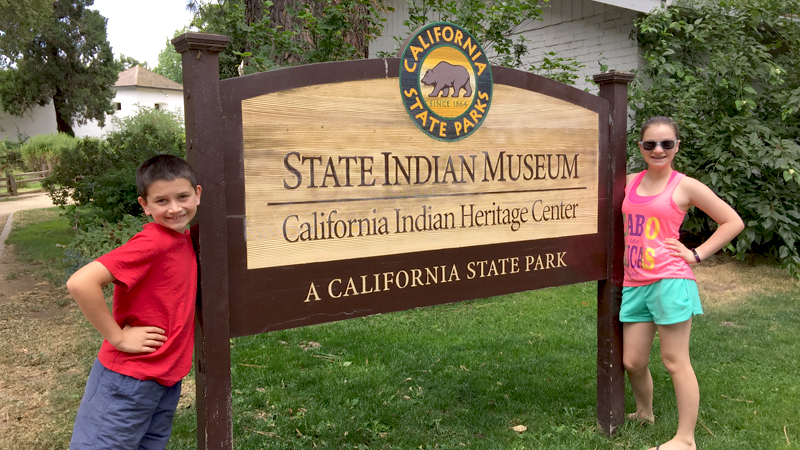
During our visit to Sutter’s Fort State Historic Park, we discovered another museum right next door — the State Indian Museum And California Indian Heritage Center. Along with the California Gold Rush, fourth graders also learn about the history of California’s native Indians, so we extended our weekend family day trip to include this museum too.
The California State Indian Museum is a very small state park that packs a punch.
It depicts three major themes of California Indian life, including Nature, Spirit, and Family, but is more focused on the local northern California themes of acorns, basket weaving and pottery. It tells the story of California’s first inhabitants. More than 60 indigenous groups, with multiple smaller bands speaking more than 300 dialects, existed here before Spanish Explorers and settlers arrived — many years before the Gold Rush.
California Indian cultural items featured include traditional baskets, along with some of the smallest in the world, a redwood dugout canoe, ceremonial regalia, beadwork, and hunting & fishing tools-some of which are more than twenty-four hundred years old. There is also an exhibit depicting the life of Ishi, reputedly the last survivor of the Yahi tribe, illustrating how Native culture was powerfully impacted and forever changed when outsiders arrived.
No photographs are allowed in the museum, which was a bit of a bummer, but here are a few I grabbed from the museum website:
Facts we learned about the diverse California Indian cultures:
- Archaeological evidence shows people have been here for as long as 14,000 years.
- California Indians have an ancient spiritual relationship with the land — believing everything and everyone is connected.
- Most native people hunted and gathered, and others managed food using self-sufficient agriculture. These methods provided enough food to feed themselves and their families for the coming year.
- Hunting, fishing, and gathering were done with an appreciation for nature. Acorns from oak trees yield acorns, a staple food source in the Sacramento and Central Valley regions. At times, acorn meal made up as much as 80% of their diet.
- Native women created a variety of baskets for storage, cooking, travel containers, and gifts. Weaving materials, designs, and techniques represent specific regions and cultures.
- It is believed that more than one million Indians lived in California before the Europeans arrived.
- More than 90 languages and 300 dialects were spoken here, making California one of the most linguistically diverse areas in the Americas.
Visiting The State Indian Museum
The California State Indian Museum offers variety of annual events, including Honored Elders Day and arts and crafts markets in the spring and fall, and every Saturday in November to celebrate Native American Heritage Month, events such as basket weaving, films, literature showcases, and traditional skills showcases are held.
If you’re planning a visit to the State Indian Museum, make sure you also visit Sutter’s Fort. They are right next door to each other, and together make a perfect family day trip — especially if you pack a picnic lunch to enjoy under the big shady trees in the park.
State Indian Museum Details
- Download The Park Brochure
- 2618 K Street, Sacramento, CA 95816 — The park is located in midtown Sacramento between K and L Streets and 26th and 28th Streets
- Open daily from 10:00 am to 5:00 pm — Closed Thanksgiving, Christmas, New Year’s Day
- Metered parking Monday through Saturday, free parking on Sunday
Have Fun!







